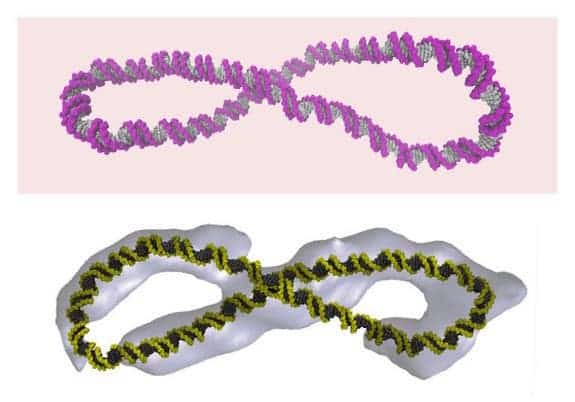DNA – you either know is as deoxyribonucleic acid, or that stuff that somehow makes us what we are. DNA is the body’s way of storing information about yourself: how the cells arrange in your body, how hereditary material is organized, and how you function. DNA is classically thought of as a distinctive double helix structure, but coiling it into new shapes could raise interesting new possibilities, a new study has found.

New research shows that DNA coils into crazy shapes. Here, images of tiny DNA looped into a figure-8, frozen and viewed with microscopy (yellow), with a computer simulation of its predicted shape superimposed. (The purple is also a computer simulation)
Credit: Thana Sutthibutpong
In a study published this week in the journal Nature Communications, Dr. Sarah Harris from the University of Leeds suggests that studying these supercoiled DNA shapes could enable us to develop better drugs and treatments, especially treatments that directly affect the DNA, like chemotherapy for example.
“This is because the action of drug molecules relies on them recognizing a specific molecular shape — much like a key fits a particular lock,” Harris said in a statement. “When Watson and Crick described the DNA double helix, they were looking at a tiny part of a real genome, only about one turn of the double helix. Our study looks at DNA on a somewhat grander scale — several hundreds of base pairs — and even this relatively modest increase in size reveals a whole new richness in the behavior of the DNA molecule,” she said, referring to the famous biologists James Watson and Francis Crick who first published a paper on the DNA structure in 1953.
DNA is made of about 3 billion base pairs, and can be spread up to a distance of 1 meter; this potential meter has to coil up inside a cell nucleus – so as you can imagine… it’s coiled up a lot. To understand this process, Harris’ team “manually” coiled DNA, turn by turn, using short circular snippets of DNA made up of thousands of base pairs. What they found was that even small changes in shape can have massive effects
“Even this relatively modest increase in size reveals a whole new richness in the behavior of the DNA molecule,” Harris said.
After they developed these new shapes, they inserted an enzyme called human topoisomerase II alpha which relaxes the coil just like in the human body. This indicates that the longer shapes they obtained mimic the longer coils actually found in the human body. After that, they used special microscopy to visualize their new shapes, while also developing models of them on the computer.
This could not only indicate new features and mechanical properties of DNA, but it could help us better understand how our DNA would react to specific treatments – and design these treatments so that they don’t do anymore damage.









